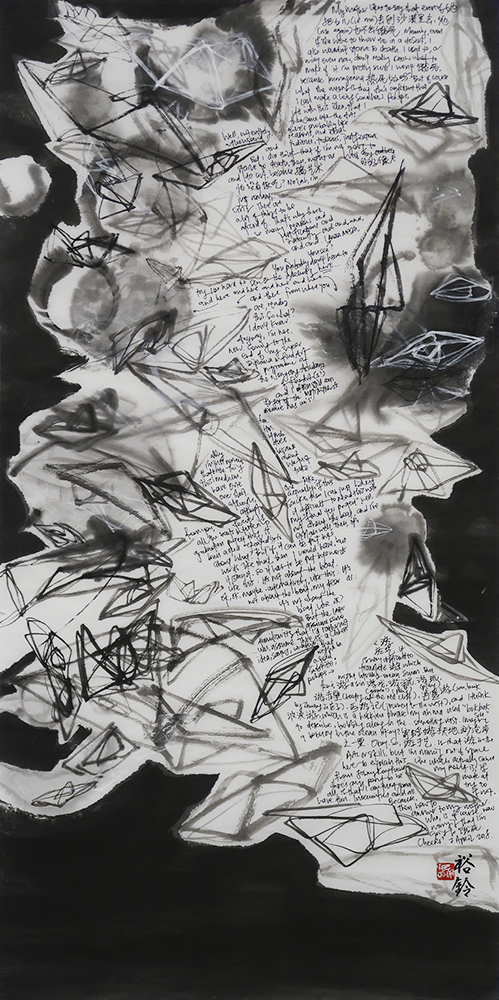It's not about the Boat 《学海泛舟》
It’s not about the Boat (INATBoat) presents reflections on art and learning art at the Nanyang Academy of Fine Arts. With “Nanyang” literally referring to the “Southern Ocean”, the series builds upon the motif of a boat to explore conceptual and visual interrelations between Chinese calligraphy (or shufa) and ready-mades.
INATBoat may be equally read as an effort to extend the boundaries of Chinese ink practice (which has long been a multidisciplinary practice[1] ) to include Western mediums, or to subsume Chinese ink under Western narratives as installation or performative work.
The motif of the paper boat also refers to the idea of the toy. These paper boats are the artists’ contemporary substitutes for the ornamental playthings Chinese literatis traditionally enjoyed collecting for their studies. These playthings are known as 文玩 (literally “literary play”).
The creative and research process behind the works in this series extends on this idea as well and refers to “翫” (read “wan”). 翫 is the traditional Chinese character for “play” (玩) and combines the grapheme for learning (习) and play (玩), referring to a definition of play which is to play through practice and learning, and thus, is akin to experimenting. This approach is elaborated in Lin Yutang’s The Enjoyment of Culture which argues that “art is creation and recreation” [2] and existentialist and humanist Albert Camus’s proposal in The Myth of Sisyphus for artistic activity to be taken as one of the key attitudes to face the absurd.[3]
Not all of the works in the series are featured here as some have yet to be exhibited.
[1] Especially since the Sung Dynasty, in combining poetry, calligraphy, drawings, and seal. The viewing of art in a personal space is traditional for Chinese ink practitioners and audiences, who have always been encouraged to regard the practice as part of one’s lifestyle, which is encapsulated in one’s art.
[2] Lin Yutang. (1937). The Importance of Living. New York: The John day Company, Inc. p. 362-395. This chapter of Lin’s book recommends approaches and attitudes towards the creation of art and literary, and how one might find enjoyment in its pursuit.
[3] Flynn, Thomas. R. (2006). Existentialism: A Very Shot Introduction. Oxford University Press. P. 5-8. “It is into this world of limited and relative observation and assessment that the existentialist enters with his/her drive to ‘personalise’ the most impersonal phenomena in our lives… it is a defining feature of existentialist thought and method that they carry an ontological significance as well. They articulate our ways of existing and provide access to the meaning and direction of our lives.”
![Installation [the artist is in residence], 2018](https://images.squarespace-cdn.com/content/v1/52491b73e4b05a24380f1ef8/1571377481462-MLUSUQ63NYE4YXHR2P0F/INATBoat+cropped+pano.jpg)
Installation [the artist is in residence], 2018
This is the complete installation depicting an artist’s studio, and her ongoing research on the connections between Chinese ink art and Western conceptual art.

It's not about the book (after 5 by 5)
After Singaporean artist Cheo Chai Hiang’s 5' x 5' (Inched Deep) 1972
This work was conceived after interacting with Cheo Chai Hiang, for an exhibition requiring artists to create a work departing from a blank sketch book.
Presented at Where is the Line? exhibition, 2018
![[Floating a paper boat]](https://images.squarespace-cdn.com/content/v1/52491b73e4b05a24380f1ef8/1571371146807-6HH7M2BSOP4KHVQ4QANO/IMG_1897+b.jpg)
[Floating a paper boat]
A 3-dimensional painting. Chinese ink and rice paper
Also as a digital print of photograph.

Transformation
60 x 85 x 5 cm, an installation, rice paper

Paper boats 《纸船》
Ink on paper
69 x 138 cm

It’s not about the Boat: (Not titled)
Ink on paper
69 x 138 cm
This work presents abstraction from the paper boat drawings, while building on calligraphic strokes. It suggests drawings and paintings as expressions of visual likeness and more. The inscriptions from the LatterRed Cliff Rhapsodyare about going with the flow, resonating with the drawing’s musical inspiration.

It’s not about the Boat: (Not titled) (Black)
Ink on paper
69 x 138 cm
This work abstracts from formal likeness even further with expression and different line and surface qualities.

It’s not about the Boat: Dear 《游於艺》
Ink on paper
69 x 138 cm
The combination of painting and literary writing refers to the Chinese ink painting tradition. On the surface, the spontaneously authored essay explains the Chinese ink painting process, the series and my artistic aspirations, but is really a reflection on the transience and irrevocability of life.


Boating at Red Cliff 《前赤壁赋》
Ink on paper
35 x 138 cm
This classical Chinese calligraphy is of a lyrical prose by Su Shi, relating a boating experience, and ideas about transience.
临文征明书

后赤壁赋
6尺



